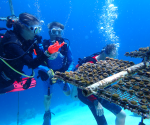Nature Foundation Warns About Increased Potential for Large Scale Sargassum Invasion

COLE BAY — The St. Maarten Nature Foundation is warning of a potential significant influx of Sargassum seaweed in the coming days: “We have been coordinating our monitoring efforts with our partners in the region and based on weather predictions, satellite imagery and aerial surveys there is a significant amount of the seaweed headed in our general vicinity.
“We have been really trying to work both with our partners in the region and with local stakeholders to monitor the situation and to find a way to control the amount of the weed washing up on beaches in the case of a significant influx. In the case of an influx we need to find a way to coordinate the removal of the seaweed with heavy loaders which causes serious risks to nesting sea turtles and hatchlings while the grass itself can be a hazard to the animals. Uncoordinated seaweed removal can also cause significant erosion on affected beaches,” commented Nature Foundation Manager Tadzio Bervoets.
“Economically speaking there is a serious effect that seagrass can have on the beaches of the island. As soon as the grass is cleared it is being deposited back on the beach by the wind and currents. We will continue to work towards researching the effects of the grass and some possible solutions but at this point Sint Maarten, like many islands in the Caribbean, are being heavily impacted,” continued Bervoets.
Sargassum is a genus of brown (class Phaeophyceae) seaweed which is distributed throughout the temperate and tropical oceans of the world. Most of the Sargassum Seaweed lies concentrated in the Sargassum Sea, a region in the middle of the North Atlantic Ocean surrounded by ocean currents. It is bounded on the west by the Gulf Stream; on the north, by the North Atlantic Current; on the east, by the Canary Current; and on the south, by the North Atlantic Equatorial Current.
Sargassum first plagued the Caribbean and St. Maarten in 2011 and 2012, with the Foundation having to warn swimmers to avoid swimming in Guana Bay in August and September due to the large amount of Sargassum Weed and many beach front residences and hotels having to continuously clean washed up Sargassum.
The Nature Foundation will continue to monitor the situation and will issue releases as information becomes available.


























